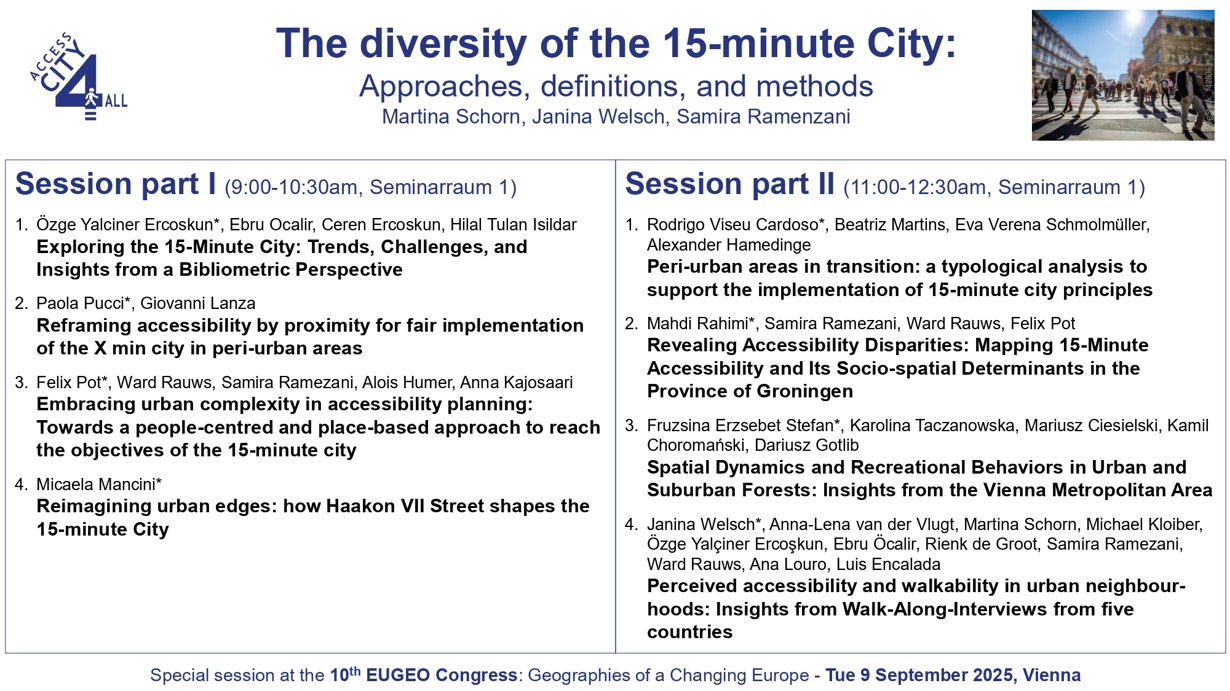10th EUGEO Congress
Geographies of a Changing Europe
Exploring the 15-Minute City: Trends, Challenges, and Insights from a Bibliometric Perspective
Ozge Yalciner Ercoskun, Ebru Ocalir, Ceren Ercoskun, Hilal Tulan Isildar
Gazi University, Turkiye
The 15-Minute City concept has emerged as a transformative approach to urban planning, aiming to create sustainable, livable, and resilient urban environments by ensuring essential services and amenities are accessible within a 15-minute walk or bike ride. Beyond its functional goals, the concept represents a paradigm shift towards fostering community, inclusivity, and human-centered urban design. This study offers a comprehensive bibliometric analysis of the 15-Minute City concept, addressing its spatial and social characteristics, sustainable mobility.
Using data from the Web of Science and Scopus, and employing tools such as Vos Viewer, the study identifies key trends, research gaps, and influential contributions within the field. Three types of bibliometric indicators—quantity, quality, and structural—are applied alongside network analyses, including co-keyword, co-authorship, and co-citation mapping, to cover significant clusters in the 15-Minute City literature.
Despite its growing prominence, the concept lacks a unified definition, with interpretations ranging from 15-minute neighborhoods to similar initiatives like healthy streets. This study systematically examines global research patterns, offering insights into the most productive authors, institutions, and countries, as well as influential topics and sources. It highlights the challenges of integrating theoretical frameworks with practical implementations and addresses gaps in longitudinal and interdisciplinary research.
Findings from this analysis provide actionable insights for researchers and practitioners to develop strategic publication plans and advance the discourse on the 15-Minute City. By identifying critical research directions and fostering collaboration across disciplines, this study contributes to refining the concept’s framework and enhancing its practical applicability. Ultimately, the research underscores the potential of the 15-Minute City to transform urban living by promoting sustainability, accessibility, and community well-being. This study is part of the DUT-funded project, AccessCity4All.
Perceived accessibility and walkability in urban neighbourhoods - insights from Walk-Along-Interviews from five countries
Janina Welsch1, Anna-Lena van der Vlugt1, Martina Schorn2, Michael Kloiber2, Özge Yalçiner Ercoşkun3, Ebru V. Öcalir3, Rienk de Groot4, Samira Ramezani4, Ward Rauws4, Ana Louro5, Luis Encalada5
1ILS Research gGmbH, Germany; 2Austrian Academy of Science, Austria; 3Gazi University, Türkiye; 4University of Groningen, Netherlands; 5University of Lisbon, Portugal
The 15-minute-city concept aims to support a sustainable urban transition in European cities and active mobility, especially walking. In order to do so, urban neighbourhoods should provide good pedestrian infrastructures and access to relevant services and places.
While the concept is most promising for promoting the quality of life of citizens, the land use pattern and transport infrastructure, and thus accessibility, vary within the city and between neighbourhoods. There is also an individual dimension of accessibility, as the level of perceived accessibility is moderated by peoples’ needs and abilities and their personal circumstances. Lack of (walking) accessibility can lead to social exclusion, or poor health and wellbeing outcomes. Therefore, it is important to recognize the vital role of the neighbourhood level as well as to consider special needs to further develop the 15mC concept.
As part of the AccessCity4All project, we conducted qualitative Walk-Along-Interviews (WAI) with senior citizens and families with smaller children which are considered more vulnerable in terms of their mobility. We aim to better understand their mobility and accessibility needs and the perceptions at the street-level as well as their links to key components of the 15-minute-city concept. The interviews were conducted in autumn 2024 in five cities/regions: Vienna (Austria), Münster (Germany), Groningen (Netherlands), Lisbon (Portugal) and Ankara (Turkey). While walking together in the neighbourhood and directly experiencing the urban environment, the interviews centred around walking experiences and perceived accessibility.
In our presentation we will present first results from these interviews. We will look into similarities and differences from a cross-country comparison. This presentation will provide examples of perceived accessibility and about relevance of services for people’s everyday lives. We will also provide a deeper understanding of supporting and hindering factors for walking and discuss the special needs and perceptions of the vulnerable groups studied. In our conclusions, we will emphasize possibilities on the integration of our findings into future research and planning practices.

